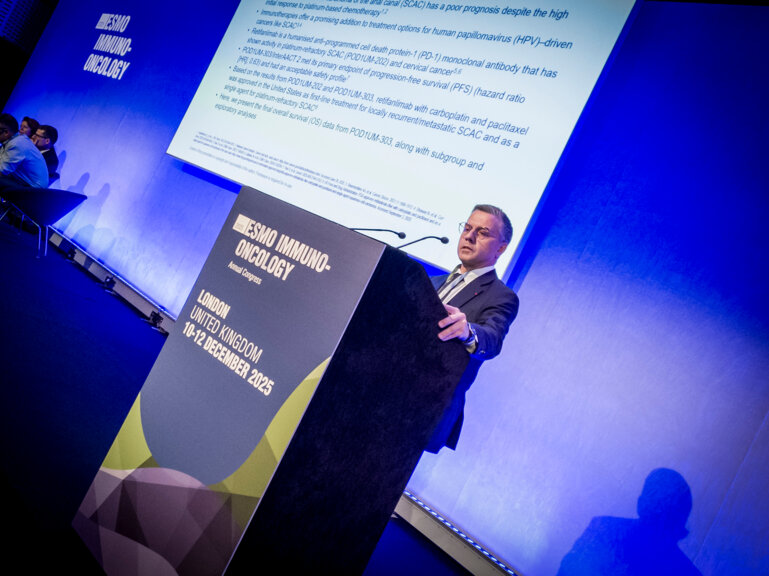Data from new clinical trials reported positive results of radioligand therapy over everolimus and sunitinib, and explore the combination of everolimus and somatostatin analogues
For patients with advanced gastroenteropancreatic neuroendocrine tumours (GEP-NETs), a heterogeneous group of tumours located in the gastric mucosa, the small and large intestine, the rectum or the pancreas, the year 2025 has started with some promising data from research that may help refine treatment strategies in the first-line setting.
As presented at the 22nd Annual Conference of the European Neuroendocrine Tumors Society (ENETS) in March, initial results of the prospective, randomised, controlled, open-label Phase III COMPETE trial showed that treatment with radiopharmaceutical agent [177Lu]Lu-edotreotide demonstrated a statistically significant clinical benefit compared with protein kinase inhibitor everolimus in patients with grade 1 or 2 metastatic GEP-NETs. In the study, which involved a total of 309 patients with grade 1 o 2 inoperable, progressive, somatostatin receptor-positive GEP-NET, the radioligand therapy led to a prolonged median progression-free survival (PFS) compared to everolimus (23.9 versus 14.1 months, respectively) [p=0.022; hazard ratio (HR) 0.67; 95% CI 0.48, 0.95].
At a median follow up of 40.9 months, a lower proportion of patients in the 177Lu-edotreotide arm experienced treatment-emergent adverse events (TEAEs) compared to those treated with everolimus (82.5% vs 97.0% respectively), and the radioligand therapy was overall well tolerated. “COMPETE is the first trial to directly compare peptide receptor radionuclide therapy (PRRT) to targeted therapy in patients with pancreatic neuroendocrine tumours and non-functioning gastrointestinal NETs, pretreated or treatment naïve. It is a practice-informing trial, supporting PRRT as the preferred choice over everolimus, given its significant advantage in PFS and more favourable toxicity profile. While overall survival data remain immature, PRRT appears to offer greater long-term benefit than everolimus,” says Dr Melissa Frizziero, The Christie NHS Foundation Trust, UK, commenting on the study findings. The positive findings of the COMPETE study support the early use of PPRT, aligning with the results of another study, the NETTER-2 in grade 2 and well-differentiated grade 3 NETs (Lancet. 2024 Jun 29;403(10446):2807-2817).
“Another notable aspect is that PRRT was administered without concurrent SSA, except in functioning tumours. Despite this, PFS remained around two years suggesting that SSA may not be essential unless required for symptom control.”
At ENETS’s conference, secondary results of the OCLURANDUM trial evaluating the antitumour efficacy of PRRT with 177lutetium-octreotate (OCLU; octreotate is synonymous with DOTA-TATE) versus sunitinib in patients with advanced progressive pancreatic NETs were also presented. Primary endpoint data from the study were discussed at the ESMO Congress 2022 showing a significantly longer PFS with PRRT with OCLU versus sunitinib within 12 months according to RECIST 1.1. A higher PR rate was reported with 177lutetium-octreotate compared to sunitinib (63% versus 30%) with a median PFS of 20.7 months in the OCLU arm (95% CI 17.2–25.5) versus 11 months in the sunitinib arm (95% CI 8.7–13.7) while a longer median overall survival (OS) was reported with the oral targeted therapy compared to the PRRT (64.4 vs 55.8 months). The median follow up was 72.5 months. Frizziero comments that “this trial once again shows that PRRT is an effective treatment for patients with pancreatic NETs, offering superior medium-term survival and improved tolerability compared to oral targeted therapy, reinforcing findings from COMPETE, including that the addition of an SSA to PRRT may not be necessary. However, OS was numerically higher for sunitinib, with approximately half of the patients in each group crossing over, suggesting that the timing of PRRT may not impact long-term survival as much as it may do on PFS. Notably, the higher probability of response, with an impressive response rate of approximately 60%, supports prioritising PRRT where rapid tumour debulking is required.”
The benefit of adding SSA to oral targeted agents for well-differentiated GEP-NETs is still matter of debate. Earlier this year, findings from the phase III JCOG1901/STARTER-NET trial showed that first-line combination of the SSA lanreotide plus everolimus led to a significant improvement in PFS compared to everolimus monotherapy in patients with unresectable or recurrent GET-NETs (J Clin Oncol 2025, 652-652). The results of the interim analysis conducted in 145 patients were presented at the 2025 ASCO Gastrointestinal Cancers Symposium. The median PFS was 11.5 months in the everolimus arm and 29.7 months in the combination therapy arm [HR 0.38; 99.91% CI 0.15–0.96; p = 0.00017]. The objective response rate (ORR) and disease control rate (DCR) were 8.7% (6/69) and 87.0% (60/69) in the everolimus arm and 26.8% (19/71) and 91.5% (65/71) in the everolimus plus lanreotide arm, respectively.
“The combination induced responses in approximately one-quarter of patients, providing a compelling argument for its use as upfront treatment in patients where tumour debulking is the priority (e.g. high disease or symptom burden) and chemotherapy or PRRT is contraindicated”, notes Frizziero. “Although this is a positive study, the tolerability of the combination therapy is concerning, with nearly 40% of patients experiencing severe toxicities. This is an important aspect to take into account in treatment selection, particularly for long-term therapy in a palliative setting, and especially if longer follow-up confirms no OS benefit. Such findings may deter clinicians favouring PRRT over everolimus in both PFS and tolerability especially given the outcomes of the COMPETE trial. Another important consideration is that this study was conducted in an Asian population and, hence, the findings require validation in other ethnic groups.”






